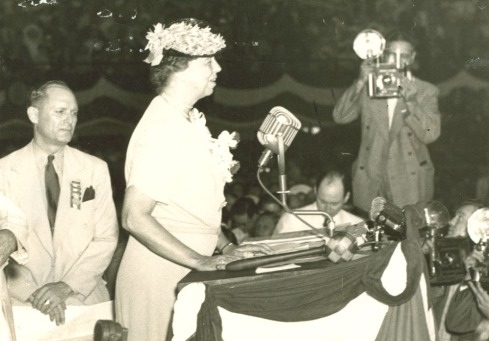You are currently browsing the tag archive for the ‘Third Term’ tag.
“This Is No Ordinary Time”
Tensions ran high as Eleanor Roosevelt approached the podium to address the delegates of the 1940 Democratic National Convention. The prior evening’s raucous proceedings, which led to FDR’s nomination for an unprecedented third term candidacy, had been long and trying. Now FDR’s subsequent insistence on Henry Wallace as Vice Presidential running mate was unpopular and controversial. The war in Europe loomed threateningly over the American psyche and ideological differences concerning neutrality, and a host of other political issues exposed fissures in the Democratic Party ranks. The Convention was at a standstill and bordered on outright revolt.
FDR (who was in Washington) and Frances Perkins (on the ground in Chicago) encouraged Mrs. Roosevelt to immediately fly to Chicago to bring the party together. She agreed to do so, and when she appeared on stage that night she called for unified action, saying [excerpt]:
“You must know that this is the time when all good men and women give every bit of service and strength to their country that they have to give. This is the time when it is the United States that we fight for, the domestic policies that we have established as a party that we must believe in, that we must carry forward, and in the world we have a position of great responsibility.
We cannot tell from day to day what may come. This is no ordinary time. No time for weighing anything except what we can do best for the country as a whole, and that responsibility rests on each and every one of us as individuals.”
The effect of her words was transformative. A silence marked by respect and admiration followed her message, somberly and palpably shifting the atmosphere. Balloting began immediately after she sat down and the Convention went on to nominate Henry A. Wallace to run alongside Franklin D. Roosevelt in the 1940 election.
Eleanor Roosevelt delivered this historic speech using only a single page of notes:
Read the full speech online by visiting the Eleanor Roosevelt Papers Project
July 18, 1940: FDR was nominated for an unprecedented third term as president.
ER addressing the Democratic National Convention in Chicago.
July 18, 1940
FDR Library Photo Collection. NPx. 69-96.
**********
Did you know:
- On July 18, 1939 FDR released a public statement on the necessity of revision of the neutrality laws, saying that failure to do so “…would waken the leadership of the United States in exercising its potent influence in the cause of preserving the peace among the nations in the event of a new crisis in Europe between now and next January.”
- On July 20, 1944 FDR was renominated for president, becoming the first president nominated for a fourth term.
July 18, 1940: FDR was nominated for an unprecedented third term as president.
ER addressing the Democratic National Convention in Chicago.
July 18, 1940
FDR Library Photo Collection. NPx. 69-96.
**********
The New Deal Estore is a great place to shop for Roosevelt related books, gifts, and other treasures from the New Deal Store at the Roosevelt Library. Available at www.fdrlibrary.marist.edu, the Estore features everything from a selection of the latest books on the Roosevelts and their times, to T-shirts, ties and caps, multimedia, campaign memorabilia, and museum replicas. For items related to this week’s blog post, follow the links below:
Freedom from Fear 1929-1945 by David M. Kennedy
Franklin D. Roosevelt, A Rendezvous with Destiny by Frank Freidel
Commander in Chief – Franklin Delano Roosevelt, His Lieutenants, and Their War by Eric Larrabee



